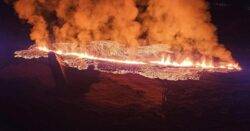A volcano in southwestern Iceland began erupting in the early hours just weeks after the Fagradalsfjall volcano blew.
According to footage from Iceland’s public broadcaster, RÚV, lava fountains were spotted soaring up into the air just shy of 8am local time.
The country’s national weather service had earlier detected 200 earthquakes at the Sundhnúksgígar crater row, with the tremors slowly making their way to the evacuated town of Grindavík.
Scientists believe the eruption is taking place south-southeast of Hagafell, the Icelandic Met Office said in a 8.47am local time update.
‘Judging by the pictures, lava is now flowing towards Grindavík,’ the agency said.
‘Based on measurements from the Coast Guard’s helicopter, the perimeter is now about 450 m from the northernmost houses in the town.’
This is the fifth volcanic eruption on the Reykjanes peninsula, the country’s most populated region, since 2021.
The Svartsengi volcanic system blew on December 18, leading to around 4,000 people in Grindavík being evacuated and the Blue Lagoon closed.
The fishing town was spared after the lava raced in a different direction – it is unclear which direction the lava from the most recent eruption is flowing.
Residents have been ordered once again to evacuate by the country’s civil defence agency, with the region’s roads closed and hiking banned.
‘Scientists are on their way to the site with a Coast Guard helicopter to assess the situation,’ the agency, called Almannavarnir, said today.
‘People are asked to use caution and avoid being in this area.’
Suðurnes police, the peninsula that covers the area of the volcanic blast, said that residents have been ordered by text to leave.
The force also had a tip for those eager to safely catch a glimpse of the glowing lava, writing on Facebook: ‘Please do not park your vehicles on the corner on Reykjanesbraut.
‘We suggest that it’s good to go to the Patterson area to watch the eruption.’
The British Foreign, Commonwealth and Development Office (FCDO) says travellers should check the Icelandic Met Office, the country’s tourism website or the civil defence for the latest updates.
‘A volcanic eruption started on the Reykjanes peninsula in south-west Iceland on 14 January, north of the town of Grindavík,’ the department’s travel advice page on Iceland says.
‘All roads to Grindavík are closed and you should stay away from the area. Keflavik International Airport is operating as normal, but you should check for latest updates. Reykjavik and the rest of Iceland have not been impacted.
‘You should monitor local media for updates and follow the authorities´ advice.’





